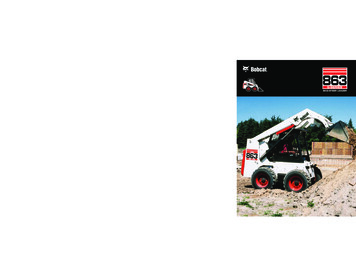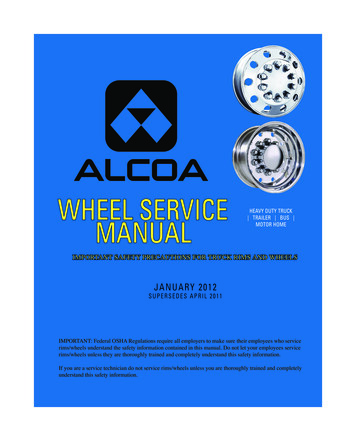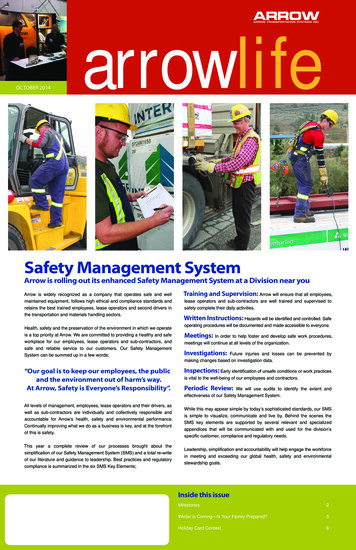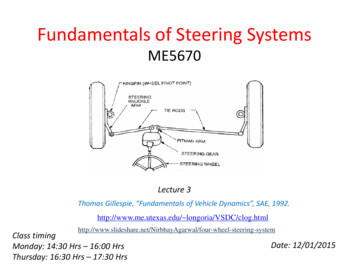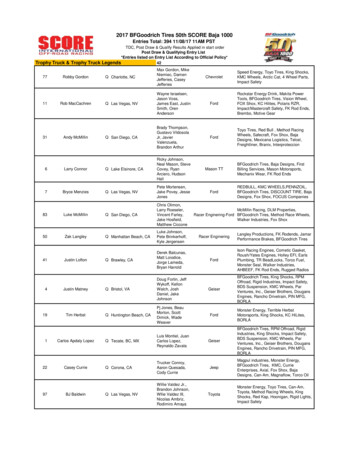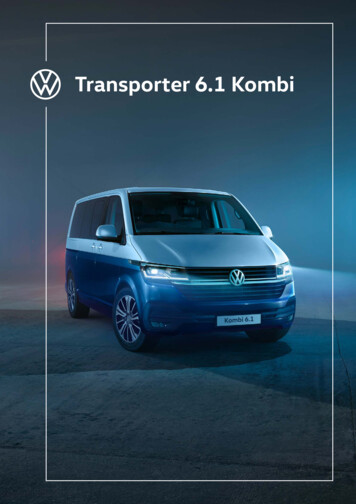
Transcription
Chapter 4 Tires, Wheels, and Brakes4.1. IntroductionThe number of tires required for a given aircraft design gross weight is largelydetermined by the flotation characteristics, which will be discussed in detail in ChapterSeven. Assuming that the number and distribution pattern of the tires is already known,this chapter provides guidelines to the selection of the tires, wheels, and brakes that willmeet the performance and safety requirements [2 and 20].As a part of the landing gear configuration definition process, tires, wheels, and brakesselection algorithms were developed based on the procedure as discussed in this chapter.Specified selection criterion, e.g., minimum size, weight, or pressure, are used to selectsuitable tires and wheels from manufacturer’s catalog [24] and industry standards [25],while statistical database was used to size the brakes as required to meet the brakingrequirements.4.2. Type, Size and Inflation Pressure of the TireThe tire selection process involves listing all candidates that meet the performancerequirements. A list of tires and wheels used on commercial transports can be found inAppendix D. The primary consideration is the load-carrying capacity of the tire during thespeed regime normally applicable for landing or takeoff cycles. In addition, the number ofplys and type of construction, which determines the weight of the tire and its operationallife, is important from an economic standpoint. Other considerations include the inflationpressure of the tire and the size of the wheel. The former must be chosen in accordancewith the bearing capacity of the airfield from which the aircraft is designed to operate from,whereas the latter must have sufficient space to house the brake assembly.30
4.2.1. Basic Tire ConstructionsRadial tires have gained growing acceptance since their introduction despite asomewhat cautious approach at the beginning, which is attributed to lack of applicablestandards, concerns about the mixability with bias tires, and retreadability of refurbishedtires. Intermixing of radial and bias tires, or even with radial tires of different construction,is possible only if the loading is no more uneven than currently encountered with mixing ofbias tires only. As for retreadability, it should be noted that multiple retreating is notnecessarily a benefit to the airlines; instead, it could be an indication of low tireperformance in terms of tread wear. Thus, the concern here is not as much how often thetire can be retreated, but how to extend the average total carcass life.In radial construction, shear stresses in the rubber matrix are minimized and loads areefficiently distributed throughout the tire. Even if the same basic materials used in bias tiresare used in the radials, the amount of material required for a particular application can bereduced. As a result, weight savings of up to 20 percent have been realized [26]. Inaddition, minimized slippage between the tire and the contact surface and the near optimaltuning of belt stiffness that comes with the radial construction all contributed to improvedwear performance. In fact, some radial tires currently achieve twice as many landings pertread as conventional bias tires [26].Operational experience has also shown that radial tires offer a greater overload bearingcapacity and withstand under-inflation better. An approximately 10-percent increase in thefootprint area improves the flotation characteristics and reduces hydroplaning on wetrunways [26]. In addition, radial tires do not fail as suddenly as bias tires do. Warningsigns such as external deformation and out-of-roundness exhibited prior to catastrophicfailure provide indications of a potential blowout to maintenance personnel, and thusenhance operational safety.31
4.2.2. Size of the TireThe choice of the main wheel tires is made on the basis of the static loading case. Thetotal main gear load (F m) is calculated assuming that the aircraft is taxiing at low speedwithout braking. As shown in Figure 4.1, equilibrium gives [5, p. 356]Fm lnWlm ln(4.1)where W is the weight of the aircraft and lm and ln are the distance measured from theaircraft cg to the main and nose gear, respectively. The design condition occurs at MTOWwith the aircraft cg at its aft limit. For single axle configurations, the total load on the strutis divided equally over the tires, whereas in tandem configurations, the load per wheeldepends on the location of the pivot point; to reduce overloading of the front wheels duringbraking, the pivot is usually positioned such that the distance between it and the front andrear wheel axles is about 55 and 45 percent of the truck beam, respectively [5].The choice of the nose wheel tires is based on the nose wheel load (F n) during brakingat maximum effort, i.e., the steady braked load. Using the symbols shown in Fig. 4.1, thetotal nose gear load under constant deceleration is calculated using [5, p. 358]Fn hcg axlm W L) ( W D T lm lnlm ln g (4.2)where L is the lift, D is the drag, T is the thrust, and hcg is the height of aircraft cg from thestatic groundline. Typical values for ax/g on dry concrete vary from 0.35 for a simple brakesystem to 0.45 for an automatic brake pressure control system [5]. As both D and L arepositive, the maximum nose gear load occurs at low speed. Reverse thrust decreases thenose gear load and hence the condition T 0 results in the maximum value [5, p. 359]Fn lm hcg (a x / g )Wlm lnThe design condition occurs at MTOW with the aircraft cg at its forward limit.32(4.3)
Lax/g WhcgFnlnD-TWDmlmFmFigure 4.1 Forces acting on the aircraft during a braked roll [5]To ensure that the rated loads will not be exceeded in the static and braking conditions,a seven percent safety factor is used in the calculation of the applied loads [2]. In addition,to avoid costly redesign as the aircraft weight fluctuates during the design phase, and toaccommodate future weight increases due to anticipated aircraft growth, the calculatedloads are factored upward by another 25 percent prior to tire selection [2].4.2.3. Inflation PressureProvided that the wheel load and configuration of the landing gear remain unchanged,the weight and volume of the tire will decrease with an increase in inflation pressure. Fromthe flotation standpoint, a decrease in the tire contact area will induce a higher bearing stresson the pavement, thus eliminates certain airports from the aircraft’s operational bases.Braking will also become less effective due to a reduction in the frictional force between thetires and the ground. In addition, the decrease in the size of the tire, and hence the size ofthe wheel, could pose a problem if internal brakes are to be fitted inside the wheel rims.The arguments against higher pressure are of such a nature that commercial operatorsgenerally prefer the lower pressures in order to maximize tire life and minimize runwaystress [26].33
4.3. Wheel DesignThe design of the aircraft wheel is influenced primarily by its requirement toaccommodate the selected tire, to be large enough to house the brake, and to accomplish theabove tasks with minimum weight and maximum life. As shown in Figure 4.2, two basicconfigurations of wheel design are currently available: A-frame and bowl-type [27]. Theformer is structurally the most efficient and therefore the lightest that can be achieved.However, this design has a limited space for housing the brake as compared to the bowltype design. Consequently, as the braking energy requirement increases with aircraftweight and hence the size of the heat sink required, it might be necessary to resort to abowl-type design even though it has a weight penalty [27].a) A-frameb) Bowl-typeFigure 4.2 Basic configuration of wheel design [27]Continued heavy dependence on forged aluminum alloy wheels is foreseen byindustry, whereas steel and magnesium alloy wheels are no longer given seriousconsideration due to weight and corrosion problems, respectively [28]. Althoughpracticable, titanium wheels are still quite expensive. Most of the premium for titaniumwheels results from the expense for the forging process, which could be 10 to 11 timesthose of aluminum alloy [28] In addition, current titanium forging tolerances have yet toreach the precision obtainable for aluminum material, thus machining of all surfaces isrequired to control weight and obtain the desired form.34
Based on statistical data, the wheel assembly weight is determined as a function of therated per wheel static load (F) and average tire outer diameter (D) [2, p. 145]fw FD1000(4.4)Given the type of material to be used, the wheel assembly unit weight is obtained fromFigure 4.3 with the weight factor (fw) as determined from Eq. (4.4).Wheel assembly weight, lb103Forged AlCasted AlFeTi102101100101102103Weight factor, fw104Figure 4.3 Aircraft wheel assembly weight [2]4.4. Brake DesignBesides the primary task of stopping the aircraft, brakes are used to control speed whiletaxiing, to steer the aircraft through differential action, and to hold the aircraft stationerywhen parked and during engine run-up. Since the heat sinks account for a significantfraction of total landing gear weight, there is a continual effort to reduce their weightthrough the application of advanced materials, namely, carbon [19].4.4.1. Heat Sink MaterialMaterial characteristics of steel and carbon are compared in Table 4.1. As shown in thetable, carbon’s high specific heat and thermal conductivity make it highly desirable as aheat absorber. The former ensures a reduction in brake weight, while the latter ensures thatthe heat transfer throughout the heat sink occurs more uniformly and at a faster rate. In35
addition, carbon retains much of its specific strength, which is defined as the ultimatetensile strength divided by density, at high temperature while steel loses almost all of itsstrength.Table 4.1 Heat sink materials comparison [2]PropertyDensity, lb/in3Specific heat at 500 F, Btu/lb FThermal conductivity at 500 F, Btu/h ft2 FThermal expansion at 500 F, 1.0E-6 in F/inThermal shock resistance index, 105Temperature limit, 1.5141.04,000DesiredHighHighHighLowHighHighLong service life and low maintenance requirements for carbon brakes prove to beanother plus from an economic standpoint. It was estimated that carbon would permit up tofive to six times more landings as compared to steel between refurbishment and wouldrequire fewer man-hours for overhaul [27]. To illustrate the economic advantage of usingcarbon brakes, it was estimated that a total weight saving of 1,200 pounds could beachieved on the Concorde using carbon brakes. This is equivalent to five percent of itsestimated transatlantic payload [29].The primary drawback of carbon brakes is that a greater volume is required to absorbthe same amount of energy in comparison to steel brakes. Some problems with carbonbrakes include sudden loss of strength due to oxidation of the carbon, temporary loss ofbraking due to moisture contamination, and high initial cost. However, these issues havelargely been resolved in favor of the performance and economic aspects of carbon heatsinks [16]. In fact, advanced transports such as the Boeing Model 777 and the emergingultra-high-capacity aircraft all feature carbon brakes.4.4.2. Brake SizingThe primary consideration in brake development is the size and weight of the brakerequired to meet the kinetic energy generated under the design landing weight, maximumlanding weight, and rejected takeoff (RTO) conditions. Brake capacity requirements forthese braking conditions are listed in Table 4.2.36
Table 4.2 FAA commercial transport brake capacity requirements [20]Design landing weightMaximum landing weightRejected takeoffSpecifications100 stops at average of 10 ft/s2 deceleration5 stops at average of 10 ft/s2 deceleration1 stop at average of 6 ft/s2 decelerationThe total kinetic energy is determined using the expression [20]KE 00443.WV 2(4.5)where V is the power-off stalling speed in knots. Assuming that the power-off stallingspeed is 1.2 times of the stalling speed (Vs), it can be approximated using the expression [5,p. 577]V 12. Vs 12.2W113. ρ SCL ,max(4.6)where ρ is the standard sea-level air density, S is the reference wing area, and CL,max is themaximum wing lift coefficient. The constant 1.13 takes into account the speed loss in theFAA stall maneuver [5]. As illustrated above, the kinetic energy absorption requirementsincrease as the square of the velocity and hence the landing speed is significant.The procedure used to size a steel brake is given here for illustrative purposes. Similardata for carbon are not available, but scaling factors of 1.28 and 0.40 can be used to relatethe steel volumes and weights, respectively, to those values for carbon [30]. Kinetic energylevels expected under the normal landing weight, maximum landing weight, and RTOconditions are first calculated using Eq. (4.5) and the appropriate aircraft weights. Brakeassembly weights (Wbrake ) corresponding to each kinetic energy level are obtained fromFigure 4.4 and averaged to arrive at a compromise value. The required heat sink volume(Vbrake ) is then approximated using the expressionVbrake 33. Wbrake 842.(8.7)where the constant coefficients are determined using linear regression analysis on statisticaldatabase[2].37
Brake assembly weight, lb500.0100 Stops5 Braking kinetic energy, ft lb x 10.0e06100.0Figure 4.4 Brake assembly weight vs. kinetic energy level [2]Given the tire wheel diameter as determined during the tire selection process, heat sinkinner and outer diameters and the volume per inch width constant are selected from Table4.3. Dividing the total volume by the constant then gives the necessary heat sink width. Theenvelope for the heat sink and torque plate carrier is established by adding 0.75 inch on theinside diameter and the end facing the wheel centerline. Finally, the piston housingenvelope is approximated by adding two inches on the actuation side of the heat sink asshown in Figure 4.5 [2].Table 4.3 Heat sink dimensions [2]Rim dia., Inner dia., 7512.75014.37515.125Outer dia., 19.50020.37521.37522.37538Volume/inch width, 195.2212.1
Rotors: keyed to the wheel and rotate with the wheelBrakes are primarilystators and rotors, forcedtogether to generatefriction, which is convertedto heat.Stators: keyed to the central torque tube,and are stationaryFigure 4.5 Key elements of carbon brakes. [See [2], pg 138 for more detailed view.]39
Chapter 4 Tires, Wheels, and Brakes 4.1. Introduction The number of tires required for a given aircraft design gross weight is largely determined by the flotation characteristics, which will be discussed in detail in Chapter Seven. Assuming that the numbe

